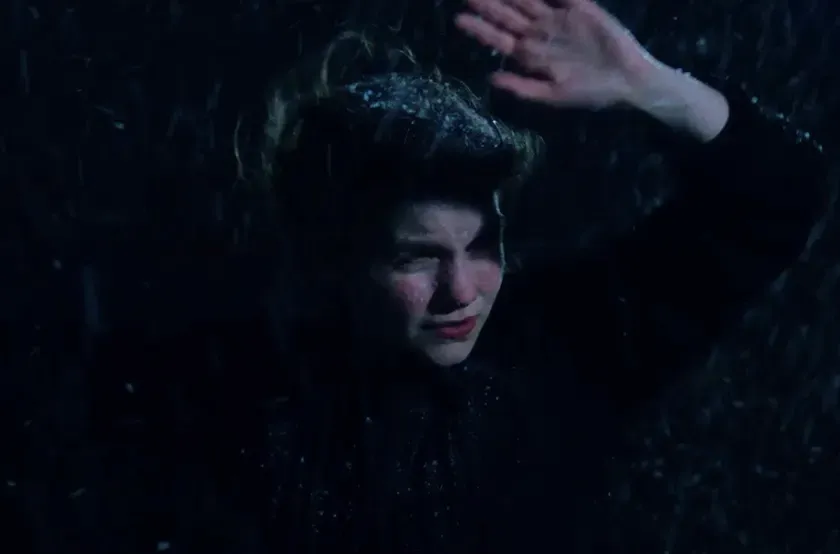At the cusp of 1900, Soudain lies buried beneath a hush of glacial winds and drifting flakes. Here, in 1899’s remote Alpine realm, time wavers between centuries as candlelight struggles against endless night. Into this suspended moment arrives Aimée Lazare, a young republican schoolteacher bearing Descartes and a satchel of scientific ideals. Her footsteps crack the pristine white, each echo a herald of friction—hygiene rituals collide with the villagers’ crust-of-dirt superstition, and her insistence on French tongues unsettles an Occitan-speaking world.
Hémon’s drama creeps like frost between joints: a slow-burn architecture of folk horror and period intimacy. Farm-stead interiors pulse with the warmth of firelight, yet shadows gather quickly around Aimée’s missionary zeal. When she draws pupils to the washstand, the hush of flowing water becomes a declaration of progress—and a provocation. Lamplights, murmurs and a distant avalanche form the film’s pulse, underscoring cultural jousts over language, ritual and scientific faith.
Each lantern-lit lesson carries the weight of epochal change, even as villagers’ distrust ripples from hut to hut. With every turn of the century page, dread coils tighter: will this emissary of reason break through ice-bound minds, or will she shatter upon the jagged cliffs of tradition?
Echoes in Snowbound Silence
Here, the Alps emerge as a living tapestry: peaks draped in sugar-white frost, earth sealed beneath permafrost, interiors aglow with flickering candle halos. Isolation becomes both sanctuary and snare—days measured by the hollow tap of cowbells inside a cramped chalet, nights stretched into eternity by the wind’s lament. In these clustered homes, life hinges on ritual: coffins mounted on rooftops until spring’s thaw, masks and fire-dance rites that blur the boundary between grief and celebration.
Women vanish into valley towns as seasonal servants, leaving children and elders to recite tales in Occitan around lantern-lit hearths. Their spoken folklore hangs in the cold air, a fragile link to vanished generations. Each avalanche-threatened slope looms like a moral fault line, reminding us that beneath still beauty lies latent violence.
Architecture and climate co-write the drama: low beams and ice-encrusted thresholds, hearth embers flickering against walls stained by smoke and superstition. Silence here is weighty—an observer’s breath becomes a secret. Yet hearth crackles offer brief reprieves, a counterpoint to glacier-quiet nights. In this crucible of wind and snow, Soudain’s geography transforms from mere backdrop into mirror of Aimée’s trials, the land’s stark austerity reflecting the human soul’s fragile hunger for warmth, connection and meaning.
Faces Against the Frost
Aimée Lazare arrives bearing Descartes and a republican zeal, convinced that reason alone will thaw frozen hearts. Galatéa Bellugi infuses her with intellectual fire—a mind that seeks emancipation through alphabet and bathwater. At first, she seems a herald of progress; by midwinter, she has become an enigma stranded beneath avalanche-threatened heights.
Her arc traces a descent from idealism into existential solitude, each lesson she imparts carving deeper fissures between her faith in science and the villagers’ ancient rites. Bellugi’s performance crackles with tension—her crisp enunciation in French slipping into hushed wonder, her fevered gaze flickering between pedagogical fervor and unspoken longing.
The children—Beloti and Nans—serve as silent judges of this upheaval. Their eyes alight with curiosity at Aimée’s planisphere and penmanship, only to narrow in guarded wariness when she challenges the crust-on-skin hygiene myth. In their shifting demeanors, the collective pulse of Soudain manifests: openness hardens into suspicion, innocence curdles under the weight of forbidden knowledge. Their reactions sketch the community’s rite of passage, testing the fragile bond between educator and pupil.
Beyond the schoolhouse door, domestic workers toil in distant valleys, leaving behind elders wedded to superstition. Old Jupiter’s creaking gait and Enoch’s disfigurement are etched in candle shadows—symbols of a world that refuses to yield. Young suitors Pepin and Samuel hover on the margins, their fascination tinged with territorial jealousy. Each interaction becomes a microcosm of power: gendered intrigue versus female autonomy, folklore policing disguised as communal protection.
Interpersonal tensions erupt in subtle betrayals—a whispered warning at dusk, a stolen page of Aimée’s notes consumed by flames. These fractures accelerate the narrative’s chill: alliances form and dissolve like ice on a mountain stream. In this crucible, every face becomes a mirror reflecting Aimée’s own vulnerability, her schoolhouse ambitions colliding with the dark question that haunts her: can the human spirit transcend its own instincts, or is enlightenment itself a brittle veneer over ancient fears?
Visions in Frost and Echoes Through Ice
Marine Atlan frames each tableau as though it were hewn from alabaster, the 4:3 aspect ratio invoking a Brueghel canvas come to life. Snowdrifts appear as sculpted waves, sugar-icing white beneath an ink-black sky. In daylight, the ridges gleam with crystalline clarity; by night, the peaks recede into void, their outlines swallowed by mountain darkness.
Within this austere visual poetry, lamplight glimmers like suspended stars. Candles pool warm amber against rough-hewn beams; hearth fires flicker, sending dancing silhouettes across frozen walls. Each low-light composition intensifies the unknown—shadows breathe, corners hold secret murmurs. The film’s texture is tactile: you feel the frost’s bite in every frame.
Sound emerges as elemental force. Footstep crunch on compacted snow resonates like an omen, while gusts of wind moan through silent village lanes. The hush between breaths is as telling as speech, a vacuum that amplifies suspicion. Emile Sornin’s score weaves ondes Martenot drones into percussive heartbeats, punctuated by choral echoes that hover at the edge of hearing. This is not mere accompaniment but a living architecture of unease.
Natural motifs serve as dramatic punctuation. An avalanche’s distant rumble shatters stillness like a cosmic gavel, reminding us of humankind’s smallness beneath geological time. Cow bells and the nocturnal clucks of chickens mark the villagers’ earthly rituals, grounding surreal dread in everyday sounds.
In the folk dance sequence, camera movements adopt a ritual sway—rhythmic, almost trance-inducing—and unease coils tighter with each turn. By contrast, the bath-time conflict hinges on sound alone: the rush of water against the hush of disapproval, a clash of cleansing necessity and ancestral fear. In these sequences, visual austerity and sonic richness converge, forging an atmosphere that feels both palpably real and hazily dreamlike—an alpine fable whispered on wind and candle flame.
Equations of Ash and Ice
Descartes by candlelight stands as a silent manifesto against centuries of flickering superstition. In one gesture, Aimée lays out her slate and ink—an eidolon of reason—only to see flames consume her careful script. Here, education is a sedition; the bath becomes a ritual of revolt. Water scours more than dirt, it scours inherited fear, a liberation that villagers greet as threat.
Aimée’s very presence cracks the village’s frozen glass ceiling. Her autonomy radiates through frosted windows, a lone torchbearer in male-dominated corridors. Sensuality seeps into her lessons—her poised glance and the warmth rising from her breath become instruments of disruption, a survival tactic as elemental as the snow underfoot. Each glance she exchanges with Pepin or Samuel pulses with unanswered questions: can desire and emancipation coexist when both tear at tradition’s seams?
Existence here teeters between life and afterlife. The Samarkand rendezvous tale drifts into classroom hush, a parable of death’s inevitability handed down by lantern. And when a coffin alights upon Aimée’s roof, the earth refuses its dead, thrusting mortality into her private domain. That coffin is neither relic nor curse but a liminal vessel between sky and soil—an emblem of fate’s ambivalence.
Language itself becomes territory. French syllables fall like foreign snow, displacing the Occitan mother tongue. Aimée, missionary and conqueror, plants republic ideals in resistant soil, her alphabet a soft occupation of minds and voices.
Above it all, the natural world presides with implacable judgment. An avalanche’s distant roar is neither villain nor ally but an impartial arbiter of hubris. Snow, dove-white one moment, becomes a tomb the next—blank slate for new thought or mausoleum for the unprepared. In this austere crucible, symbols collide: reason against ritual, emancipation against exile, each motif inscribed on the human soul like frost upon a windowpane.
Pulse of the Avalanche
The narrative unfolds like a glacier’s slow descent. Act I charts Aimée’s arrival: lantern-lit trek through knee-deep snow, her first lessons set against curious glances and whispered warnings. Cultural dissonance crystallizes swiftly—hygiene rituals clash with ancestral taboos, language becomes battleground.
Act II deepens fault lines. Community rituals—coffins on rooftops, masks and fire dances—intersect with Aimée’s lessons in equal measure. Romance simmers as Pepin and Samuel orbit her, their attractions entwined with suspicion. Conflicts escalate: a stolen notebook, a whispered accusation, bathwater draining into distrust.
In Act III, the film’s rhythm quickens: inexplicable disappearances slice through winter’s stillness, each vanishing echoing like an unanswered question. Feverish dreams and folk incantations blur line between reality and myth. The camera pulls back in an exquisite final tableau, revealing communal complicity as villagers huddle beneath avalanche-prone slopes, their gazes both accusatory and resigned.
Hémon’s pacing favors deliberate exposition before sudden surges of dread, silence employed as potent counterpoint to wind’s howl. Moments of hush expand tension, inviting the viewer’s breath to catch in unison with Aimée’s. The climax refuses neat closure: is she siren, specter or revolutionary vanguard? The film leaves these questions unsettled, entrusting interpretation to each spectator’s imagination.
Full Credits
Director: Louise Hémon
Writers: Louise Hémon, Anaïs Tellenne, Maxence Stamatiadis
Producers: Alexis Genauzeau, Margaux Juvénal, Simon Bleuzé
Cast: Galatéa Bellugi, Matthieu Lucci, Samuel Kircher, Oscar Pons, Sharif Andoura, Léna Camillieri Dorléans, Solal Griveau Martin, Lula Guaydan, Greta Saggiorato, André Borel, Amid Bouselahane, Marisa Ronchail, Annie Souche
Director of Photography (Cinematographer): Marine Atlan
Editor: Carole Borne
Composer: Émile Sornin
The Review
The Girl in the Snow
The Girl in the Snow envelops viewers in stark poetry, as Hémon and Bellugi craft a harsh fable of reason confronting ritual, where beauty and dread coalesce beneath avalanche skies. The film’s atmospheric precision and philosophical undercurrents linger long after the credits.
PROS
- Atmospheric cinematography immerses viewer in Alpine chill
- Galatéa Bellugi’s performance is commanding and nuanced
- Soundscape amplifies existential unease
- Philosophical subtext enriches period drama
CONS
- Measured pacing may test patience
- Ambiguous ending might frustrate those craving resolution
- Some supporting characters remain underused
- Heavy symbolism can obscure narrative clarity

















































